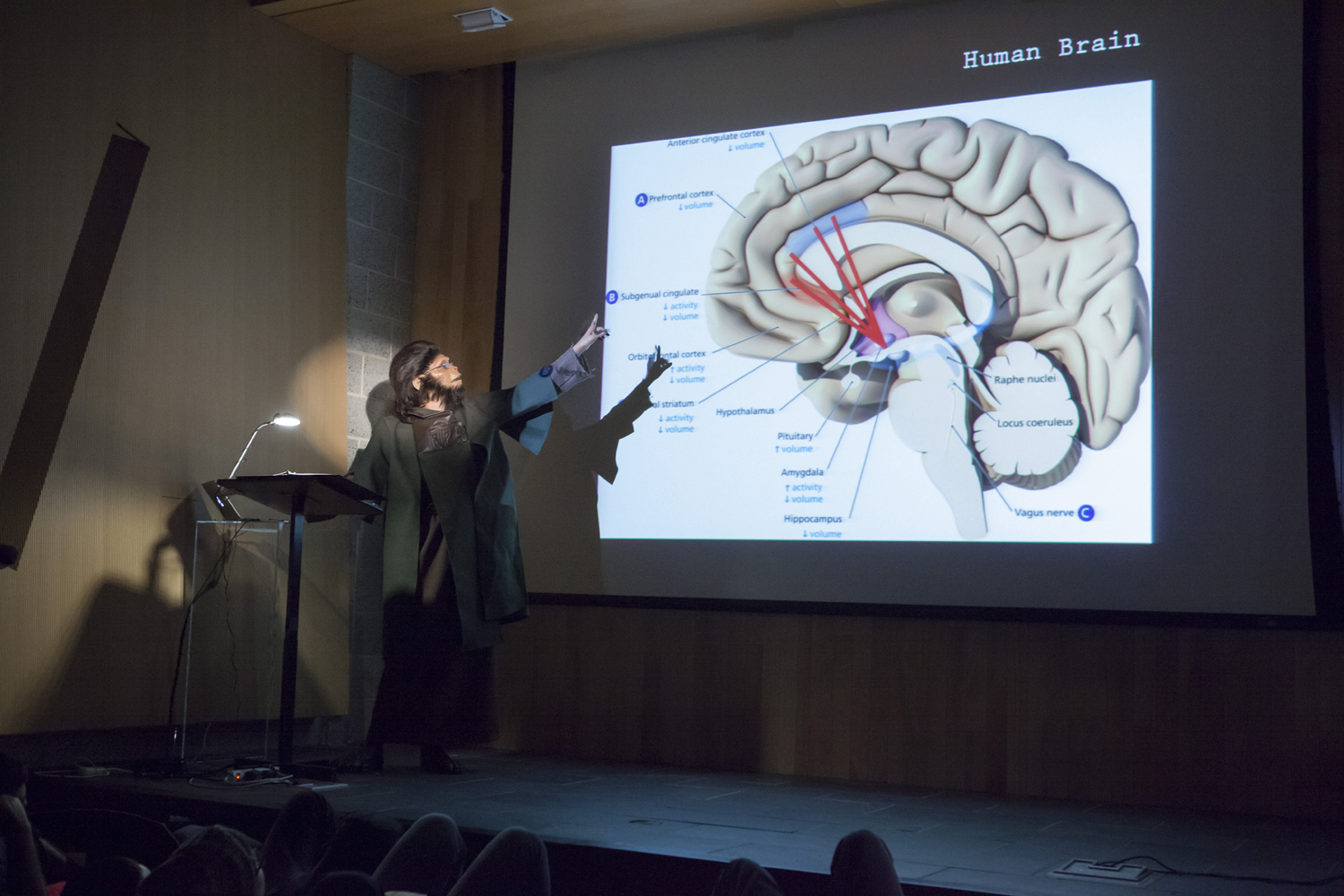
Coco Fusco. Observations of Predation in Humans: A Lecture by Dr. Zira, Animal Psychologist (study), 2013. Photo: Noah Krell. Courtesy the artist.
In her performance Observations of Predation in Humans, the artist Coco Fusco portays Dr. Zira, the female chimpanzee and animal psychologist from the 1968 film Planet of the Apes. The performance debuted in 2013 at the Studio Museum in Harlem, introduced by the scholar Donna Haraway: Contrary to the film’s narrative, in which Zira was assassinated, she escaped to the Midwest, living in seclusion for more than thirty years and observing human behavior on the Internet and television. After scientists concluded in 2012 that animals have consciousness, Zira decided to resurface and present her findings on humans. Here, Fusco discusses her revival of this unforgettable character.
Elia Alba: Were you trying to frame this new piece within the context of an earlier performance, Two Undiscovered Amerindians, which also featured subjects in a cage?
Coco Fusco: This is not the first time I have turned to the theme of the subhuman. The history of racial thought, which I have researched for thirty years, is full of ways that those designated as Other are viewed as less than human and compared to apes and other nonhuman animals. After Two Undiscovered Amerindians, Guillermo Gómez-Peña and I created Mexarcane, which dealt with the role of the exotic in contemporary global culture. That piece was presented in Canadian and US shopping malls: Guillermo was in a small cage while I interviewed audience members to determine what expression of exoticism they wanted to see. In other performances, I have appeared as an erotic fetish that attracts tourists (Stuff! with Nao Bustamante), a variety of famous Latinas worshipped after their deaths (Better Yet When Dead), a Latina sex worker in a pornographic chat room who takes orders from European clients as to which kind of perversion to enact (The Incredible Disappearing Woman), and so on.

Coco Fusco and Guillermo Gómez-Peña. The Year of the White Bear and Two Undiscovered Amerindians Visit the West, 1992-1994. Performance. Courtesy the artist and Alexander Gray Associates.
For Two Undiscovered Amerindians, I researched how the scientific discourse of the eighteenth and nineteenth centuries contributed to popular understanding of non-Europeans as subhuman; I was exploring the boundary between humans and other animals. That returns in Zira’s monologue. Zira studies humans through the lens that humans use to study nonhuman primates. That affords a way of talking about human behavior that makes it unusual, funny, and strangely similar to animals that we think of as less intelligent. Zira’s discursive style also represents a departure from the usual view of human aggression and greed, which in my mind dominates our society. So Zira’s scientific comparison of humans to other primates is my means of talking about economic polarization and neoliberalism as a form of violence.
The five original Planet of the Apes films (between 1968 and 1973) were not-so-veiled critiques of twentieth-century hubris: warfare, obsession with the nuclear bomb, inhumane treatment of animals in scientific research, lack of concern for the natural environment. The message is dark: humans destroy the Earth and civilization because they cannot control their violent urges. I borrow many aspects of that message in my piece. But in a deeper sense, the films address US race relations through allegory: humans are subjected to the same inhuman treatment that had been directed at black slaves. The eventual revolt of the ape slaves in the fourth film recalls the black urban uprisings of the late 1960s and ’70s.
EA: What does your performance as a chimpanzee at the Studio Museum in Harlem say about minstrelsy?
CF: Dr. Zira is not just any chimpanzee; I would not have chosen another famous chimp for my character! In the past few years I have taught courses on Afrofuturism, and I developed a renewed awareness of the treatment of race relations in the Planet of the Apes films. Zira stood out not only because she is an outspoken feminist and pacifist but also because she acts as a bridge between the apes in the films and the human protagonist, Taylor. Even if her culture refuses to see humans as equals, her curiosity and rigor as a scientist compel her to step outside her culture’s discursive limits. Those aspects of her character appealed to me.
EA: During the Studio Museum discussion on Afrofuturism, you talked about the neuroendocrinologist Robert Sapolsky’s research on primates. In examining hierarchy and modes of cooperation, Sapolsky found that specific primates went from a patriarchal to a matriarchal society. Do you believe a total shift in modes of cooperation is possible for humans?
CF: Sapolsky conducted research on a group of baboons that lived near human beings. Male baboons ate from the human garbage receptacles and got very ill, eventually dying. The surviving baboons were mostly female, with a few nondominant males. According to Sapolsky, this group then became a matriarchal society. They developed more cooperative means of interacting and sharing food. The group also forced other baboons that tried to join them to adapt to their matriarchal system. As for whether human beings can change, there is ample evidence that human beings can adopt more cooperative modes of interaction under certain circumstances.

Coco Fusco. Observations of Predation in Humans: A Lecture by Dr. Zira, Animal Psychologist, 2013. Performance at the Studio Museum in Harlem, New York, NY, 2013.
EA: In the performance, is Zira a cyborg?
CF: No, and the sci-fi obsession with cyborgs is a distraction. There is increased scientific interest in understanding patterns and practices of peacemaking and reconciliation in primates. In the 1960s and ’70s, when much of the highly public research on primates and language was taking place and Planet of the Apes was filmed, the focus in primatology was on aggression. My understanding is that scientists have larger ethical concerns about the negative effects of human aggression on the survival of our species, other species, and the planet. There is a sense that our aggressive tendencies are not in balance with the empathetic tendencies that are also necessary for survival.
EA: I wasn’t thinking of Zira as a physical manifestation of a cyborg. Haraway’s manifesto argues for two types of cyborg that operate at different ontological levels: one is a literal configuration of human bodies and technology, and the other is metaphorical, a “creature of fiction,” a figure that challenges assumptions and binaries. The second is how I was seeing Zira.
CF: I can see how that view fits, but I wasn’t thinking about cyborgs of any kind when I developed the piece. Haraway has written extensively about humans’ relations with nonhuman animals, and she mentioned to me that she sees Zira as a bonobo. There is a great deal of research on bonobos’ pacific nature and its relation to their matriarchal society. Haraway is very interested in what we can learn from bonobo social practices.
EA: Do you believe that Haraway’s idea of Zira as a bonobo and the Sapolsky study envision the possibility of a matriarchal future for humans?
CF: I don’t see a matriarchal future, sorry. The majority of women lead very difficult lives. Women without male partners are much more likely to live in poverty. They work in poor conditions and are victims of physical abuse. Some women have gained power, but that does not mean that the general condition of women will improve. Most affluent women are just as obsessed with power and money as men.
Ultimately, I don’t think a matriarchal order will solve the current social and economic crisis. Increased government regulation of corporate power would be a step in the right direction. Greater investment in the public sector is also important. But the capacity for empathic behavior and cooperation is not gender specific. It would be very difficult to bring about a generalized change of behavior in America. The irresponsibility and unfettered power of the wealthy is not the only problem. We live in a society that promotes self-centeredness and hyper-specialization and, as a result, few people want to do anything for others or know how to take care of themselves.
The author conducted this interview on April 26, 2014, as part of her event series and forthcoming book, The Supper Club, created in collaboration with Recess.




Pingback: The Walker Curates the News: 01.05.15 | ART21 Magazine
Pingback: Artel
Pingback: The Walker Curates the News: 01.18.15 | ART21 Magazine
Pingback: Sightseeing: the most dazzling art and design of summer 2016 | Naija Upgrade
Pingback: Sightseeing: the most dazzling art and design of summer 2016 | HotNoon